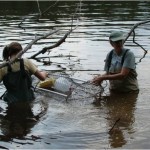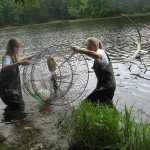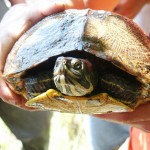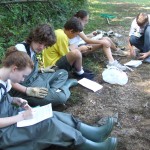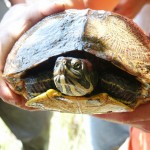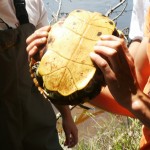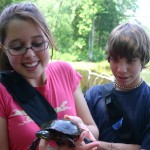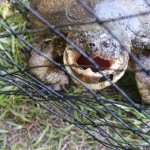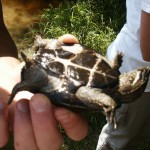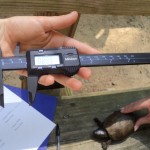About
Of the twenty-one species of turtles found in North Carolina, all but one are highly aquatic, meaning they spend most of their time in the water. How do scientists know what kinds of turtles can be found in the rivers, ponds and lakes of our state? Through scientific investigation, namely observation of the habitats where we believe these creatures might be found.
Project Overview
In this aquatic turtle study at each HRE, we use hoop turtle traps to catch and then identify aquatic turtles found in ponds, lakes, and rivers.
Inquiry Questions
What types of turtles are found in each body of water?
What is the population estimate for each turtle species?
What is the gender ratio of turtles for each species?
Does trap placement (high recreational use versus lower recreational use) affect capture rate?
Does type of bait influence capture rates (sardines, chicken legs, hot dogs)?
Data Collection
We set baited aquatic turtle hoop traps in a 13-acre lake (CCR), a pond (Elon) and a river (Rockfish). As part of this mark/recapture project, we wore chest or hip waders to set and pull traps from various positions. Once we were back on land, we removed the turtles from the traps and began to process them.
Step One: Identify the species
Students identified turtles using field guides, dichotomous keys and information provided by a wildlife biologist. They consulted a field data collection notebook to determine the appropriate marking for each species of turtle.
Step Two: Mark the shell
This was a mark/recapture study. We placed a mark on each turtle’s shell so that we could distinguish one turtle from another and to be able to tell if it had been previously captured. We made a series of three notches on specific marginal scutes (scales on the edge of the turtle’s shell).
Step Three: Measure the turtles
HRE participants measured both the carapace (top shell) and plastron (bottom shell) of each turtle. They also recorded the weight and sex of each turtle. Other information about weather and water conditions were also recorded.
Step Four: Release the turtles
All turtles were photographed (both carapace and plastron) and released back into the same location where they were found.
Data Sheets
We use the following data sheet for recording details on each turtle.
Download Data Sheets:
Aquatic Turtle Morphometric Data Sheet (Word)
Aquatic Turtle Morphometric Data Sheet (PDF)
Summer 2012 Aquatic Turtle Contact Data (Word)
Species Identified
Chestnut Ridge Camp and Retreat Center
Yellowbelly Slider (Trachemys scripta scripta)
Painted Turtle (Chrysemys picta)
Common Snapping Turtle (Chelydra serpentina)
Eastern Mud Turtle (Kinosternon subrubrum)
Musk turtles (Sternotherus odoratus)
Red-eared Slider (Trachemys scripta elegans)
River Cooter (Pseudemys concinna)
Elon University
Yellowbelly Slider (Trachemys scripta scripta)
Common Snapping Turtle (Chelydra serpentina)
Red-eared Slider (Trachemys scripta elegans)
Rockfish Camp and Retreat Center
Yellowbelly Slider (Trachemys scripta scripta)
Painted Turtle (Chrysemys picta)
Common Snapping Turtle (Chelydra serpentina)
Eastern Mud Turtle (Kinosternon subrubrum)
Musk turtles (Sternotherus odoratus)
Red-eared Slider (Trachemys scripta elegans)
River Cooter (Pseudemys concinna)

